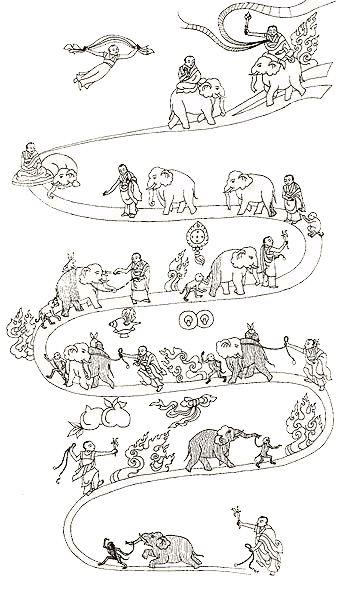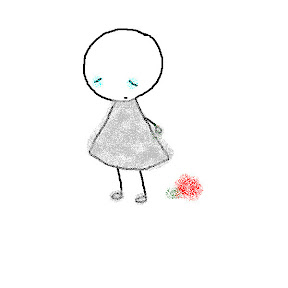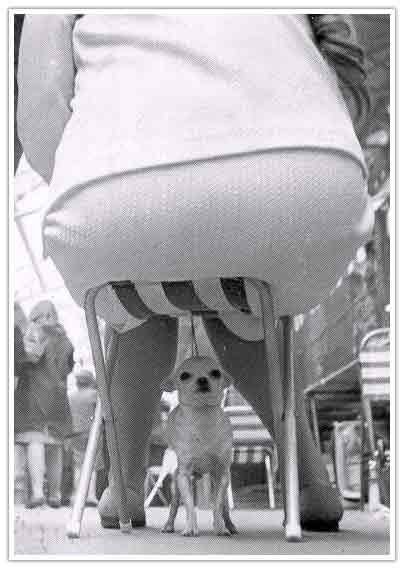
Like a wayward puppy, your mind means well — it just has a will of its own and some pretty obnoxious habits to unlearn. Just as you wouldn’t hit a puppy for peeing on the carpet, but you would keep carrying it patiently back to its little pile of papers, you need to keep leading your wandering mind patiently back to its focus of concentration, without anger or violence or judgment of any kind. After all, you want your “puppy mind” to like you and treat you as a friend, instead of cowering in your presence. In fact, your mind deserves even more patience than a puppy because it’s developed the tendency to fantasize, worry, and obsess through a lifetime of poor training. As you practice being kind and patient with your mind, you naturally soften and relax into the present moment — which is, after all, the point of meditation. On the other hand, if you force your mind to concentrate like a drill sergeant pushing his troops, you’re just going to wind up tense and uncomfortable — and you probably won’t be motivated to meditate again. As I note in other chapters, discovering how to meditate is a lot like practicing a musical instrument. First you need to assemble some basic techniques; then you get to practice the same scales over and over. Like following your breath, playing scales can seem incredibly boring — but week by week, you become imperceptibly better, until one day you graduate to playing simple tunes. And the more you practice, the more subtleties you notice, and the more interesting even playing simple scales — or following your breath —becomes.
The historical Buddha compared meditating to tuning a lute. If you make the strings too tight, they break, and you can’t play the instrument at all. If you make them too loose, you can’t get the right sounds. Likewise, you need to listen to your instrument — your body and mind — when you meditate to determine what kind of tuning you need. If you’re tense, you may want to begin with some deep relaxation; if you’re sleepy or foggy, you may need to sit up straight, pay attention, and emphasize your concentration. As you gently bring your puppy back again and again, you also get to notice the themes and stories that repeatedly draw your attention away. Perhaps your mind keeps returning to worries about job security, or arguments with your partner or spouse, or sexual fantasies, or popular songs. Whatever the favorite bones your puppy likes to chew, you gradually become familiar with them as you watch them distract you.
After weeks and months of regular practice, you develop a deeper understanding of how your mind works — and how it causes suffering and stress.
And like hit tunes you love at first but eventually get tired of hearing, the same old stories start to lose their power to disturb you, and you develop greater equanimity and peace of mind.
 Just as a tree needs to set down deep roots so it won’t fall over as it grows, you need to find a comfortable position for the lower half of your body that you can sustain for 5, 10, or 15 minutes — or even longer, if you want. After several millennia of experimentation, the great meditators have come up with a handful of traditional postures that seem to work especially well. Different though they may appear from the outside, these postures have one thing in common: the pelvis tilts slightly forward, accentuating the natural curvature of the lower back.
Just as a tree needs to set down deep roots so it won’t fall over as it grows, you need to find a comfortable position for the lower half of your body that you can sustain for 5, 10, or 15 minutes — or even longer, if you want. After several millennia of experimentation, the great meditators have come up with a handful of traditional postures that seem to work especially well. Different though they may appear from the outside, these postures have one thing in common: the pelvis tilts slightly forward, accentuating the natural curvature of the lower back.



 When talking about the practice of sitting still, one of my first meditation teachers, the Zen master Shunryu Suzuki, used to say that the best way to show a snake its true nature is to put it into a hollow stick of bamboo. Take a moment and give this unusual metaphor some thought. What could he have possibly meant by it?
When talking about the practice of sitting still, one of my first meditation teachers, the Zen master Shunryu Suzuki, used to say that the best way to show a snake its true nature is to put it into a hollow stick of bamboo. Take a moment and give this unusual metaphor some thought. What could he have possibly meant by it?










































